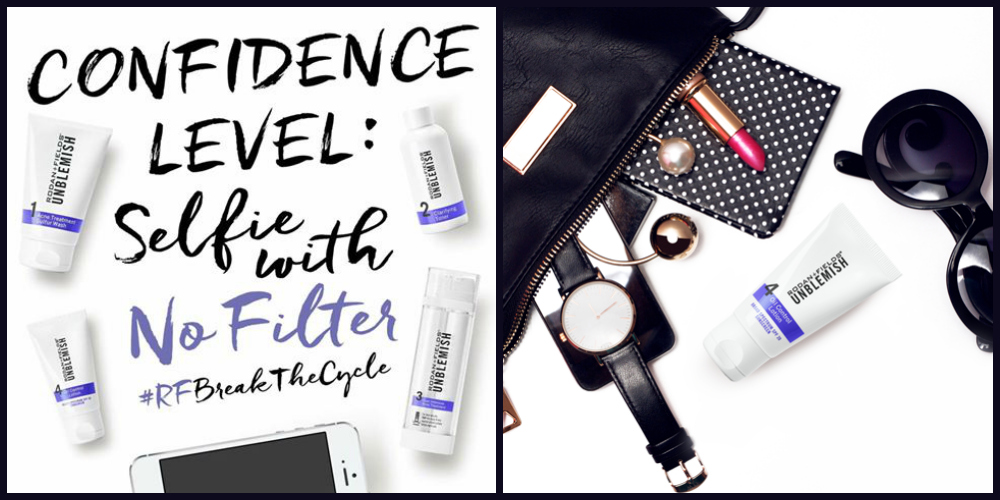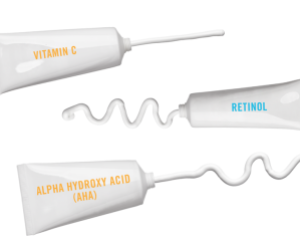by Debi G | Aug 5, 2016
No one likes a pesky pimple, especially me. I have been plagued by acne all of my life and I have the battle scars to prove it. High School was one big pimple for me 🙁 So what do I do now? I follow these easy tips to stay ahead of acne to score flawless-looking skin:

~ Wash your face both before bed and in the morning.
A whole day’s worth of dirt, oil and even environmental pollution can coat your face by the end of the day. Likewise, hair products can rub off onto your pillow, and from there end up on your cheeks, so it’s important to start clean every morning.
It’s important to remove layers of dead skin cells and dirt so they don’t block your pores. Gentle exfoliation also keeps your skin glowing.
~ Don’t pick or pop.
Disturbing a pimple can cause infections and make it worse, sometimes leaving a scar. Dab a sulfur treatment on the problem area twice a day to bring down the swelling, or try UNBLEMISH Acne Treatment Sulfur Wash to unclog pores and reduce visible redness.
~ Keep it simple.
Too many products can aggravate your skin. The UNBLEMISH Regimen is a simple, four-step continuous solution that addresses the acne cycle, eliminating most acne blemishes before they are visible on the skin’s surface.
~ See your dermatologist. If you’re still having acne challenges, see your dermatologist for a consult.
There’s one thing to remember if nothing else: you should continue doing what works for you. To quote Dr. Katie Rodan and Dr. Kathy Fields, “When it comes to beating acne, success is routine.”
Know someone with pesky pimples? Message me and let’s get them some help!!! #teamenthusiasm #pimplefree #unblemish
Share this with someone you think this could help!
For more information contact me:
by Debi G | Jul 25, 2016
Have you thought about this???
We’re not used to living without our smartphones, tablets and laptops for any amount of time—whether we stay indoors or go out.
But, have you ever considered that using your device outdoors could have serious consequences for your skin? Think of those old-fashioned, foil tanning reflectors to envision how screens can reflect the sun onto your face, neck and under your chin—the vulnerable spots that might not be shielded by a hat or sunscreen.
Researchers at the University of New Mexico wondered about this UV exposure from screens in natural sunlight and how it might increase cumulative UV exposure over a lifetime. As reported in the Journal of the American Academy of Dermatology (September 2015), they found that when a smartphone was held at close range, UV exposure increased by 36 percent!!!
Wherever you choose to spend your days, limiting your sun exposure (or avoiding it altogether) is the most effective preventative measure to protect your skin from sun damage and aging.
If you must chat, tweet or surf the internet outside, always apply a broad spectrum sunscreen, like REDEFINE Triple Defense Treatment SPF 30, or Reverse #4 so you don’t get “burned” by your smart devices. To achieve a golden glow year round without catching any UV rays while you text, try ESSENTIALS Foaming Sunless Tan. We’ve got you covered!
Be sun smart—especially if you spend a lot of screen time outdoors.


by Debi G | Jun 17, 2016
 FICTION. Mixology may be a fun way to find your signature cocktail, but combining too many different skincare products is not likely to produce the results you’re after. Plus, if you’re not careful, product mixing can actually aggravate, rather than improve, your skin.
FICTION. Mixology may be a fun way to find your signature cocktail, but combining too many different skincare products is not likely to produce the results you’re after. Plus, if you’re not careful, product mixing can actually aggravate, rather than improve, your skin.
What’s the trick to multi-product success? Start by familiarizing yourself with the active and cosmetic ingredients in your skincare routine so you can recognize (and avoid) the most common mixology problems:
1) A lose-lose situation. Sometimes the ingredients in different products counteract each other, which means you won’t see the intended benefits of either product on your skin (for example, alpha hydroxy acids cancel the benefits of vitamin C-based products).
2) Tandem irritation strikes. In other words, your skin is fine when the products are used independently, but use them together, and hello skin irritation. This is common when combining multiple products with anti-aging benefits (think: retinol and alpha hydroxy acids).
3) Beware of product incompatibility. This is easy to test for by rubbing your face after the second product has dried. If it peels, balls, or curdles, you’re looking at products that don’t mix.
These ingredients simply don’t play nice with each other:
Retinol.* This derivative of vitamin A is a must-have when it comes to visibly improving skin texture and minimizing the appearance of pores. However, dryness, redness or irritation can result from mixing retinol with glycolic acids, alpha hydroxy acids (in many wrinkle-minimizing products), or salicylic acids (in acne treatments). It’s no surprise then, retinol and the acne-fighting ingredient benzoyl peroxide actually deactivate each other.
Citric acid. Commonly found in moisturizers, this effective ingredient is destined to be a loner. Citric acid often causes irritation if layered with other products.
Alpha hydroxy acids (AHA) and vitamin C. These acid-based ingredients actually destabilize each other, leaving the antioxidants ineffective, so choose products with one or the other—but don’t combine them or you risk redness, peeling and irritation. Also, steer clear of retinol if you’re using either of these acids.
Word to the skin-wise: Get to know the ingredients that work in harmony with your skin (and with each other)—but leave the mixology to dermatologists. Stick to a collection of products clinically designed to work together, and your skin will thank you.


by Debi G | Jun 10, 2016

The hair, the makeup, the dress…your skin? That’s right, whether you’re the bride-to-be, a bridesmaid or a VIP guest, you want your skin to be as smooth and flawless as the wedding. But how do you get your complexion to say “I do” for the big day too?
Achieving a radiant, wedding-worthy complexion can be a time investment, so start as early as you can. Introduce new skincare, from cleansers to makeup to sunless tanners, no less than a month before the date, so you can eliminate any products that trigger even the slightest irritation.
If you don’t have any complex skincare concerns, and you want smoother, softer, more even-looking skin—exfoliation is one of the safest, simplest ways to get your skin glowing. Even the best makeup won’t hide the look of uneven skin texture, so consider ENHANCEMENTS Micro-Dermabrasion Paste, which uses sugar and salt to gently exfoliate. You can start using it up to one week before the wedding to remove old, built-up skin cells and allow younger, more vibrant cells to appear on the surface—and skin looks brighter after just one use.
Don’t exfoliate if you have a skin concern like adult acne. Instead, consider the UNBLEMISH Regimen, which targets blemishes and works to prevent future breakouts. If you’ve developed brown spots from sun exposure or hyperpigmentation, the REVERSE Regimen helps to visually brighten and even skin tone. (You might even get away with wearing less makeup.) When it comes to skincare, the most impressive results are seen over time, so plan accordingly. If the event is less than a month away, our cardinal rule is to only stick with products that are currently compatible (or are extremely gentle) with your skin.
What should you avoid? In the last four weeks, don’t even consider in-office dermatological procedures (like chemical peels or laser treatments). Resist any last-minute temptations to try new products or treatments. Keep up your natural glow by staying hydrated and moisturizing skin. Last-minute facials (except gentle exfoliation) are off limits, as are touching, picking or squeezing, which can all irritate skin. Finally, avoid unnecessary stress and over-cleansing which can cause breakouts.
If it’s an outdoor wedding, wear a wide-brimmed hat (unless you’re the bride) and apply your sunscreen (try it in advance so you can find a formula that works with your makeup).
Ultimately, through thick and thin, your skin is with you for life—so be good to it always.


by Debi G | May 26, 2016
Our modern-day “love affair” with the suntan began nearly a century ago as a status symbol of leisure, wealth and beauty. But today, with so much knowledge of the sun’s power to harm and prematurely age skin, we’re turning to safer, sunless alternatives, and embracing the ultimate answer to this beauty paradox—protection and prevention with broad spectrum sunscreen.

But did you know not all sunscreens are created equal? Understanding how they work is key. May is Melanoma Awareness Month, so now is the perfect time to boost your sunscreen smarts:
- Use a broad spectrum sunscreen. It blocks both types of the sun’s rays: UVB (responsible for sunburns) and UVA rays (the deep, aging kind) from penetrating skin.
- Double the SPF doesn’t equal double protection. The SPF number refers to the sunscreen’s ability to block out UVB rays only. When applied as directed, SPF 15 blocks 93% of UVB rays, SPF 30 blocks 97% of UVB rays and SPF 50 blocks about 99% of UVB rays.
- Apply liberally every two hours. To achieve the full SPF benefit, the American Academy of Dermatology recommends using one ounce (a shot glassful) of sunscreen on your body and one teaspoonful (size of a quarter) on your face. If applied too thinly, an SPF 80 can act like an SPF 3.
- Ingredients matter. Zinc oxide and titanium dioxide are active ingredients in mineral-based sunscreens, like SOOTHE Mineral Sunscreen, which physically block both UVB and UVA rays and are gentle enough for sensitive skin. Acknowledged by experts and the FDA, chemical blockers (like avobenzone) absorb well into skin and offer excellent protection against UVA rays.
- Check the expiration date. Fresh ingredients make sunscreen more effective. Keep your bottle in the shade and avoid leaving it in a hot car, as excessive heat can break down the active ingredients.
- Apply rain or shine. While UVB rays are at their peak midday, UVA rays are present from sunrise to sunset and can penetrate your skin even on cloudy days—who knew? We recommend applying broad-spectrum sunscreen every morning, 15-30 minutes before heading outside.
Get to know your ideal sunscreen and combine it with other sun protection measures to stay ahead of melanoma. Wear a broad-brimmed hat and protective clothing when you step out of the shade. Even better, stay out of the sun altogether and use ESSENTIALS Foaming Sunless Tan for a healthy, natural-looking glow—and show off your sun savvy.
You are beautiful and you are worth it!!!










